|
SCORING TOOLS
Some of the weird/rare instruments I own and play
This page details some of the unique, weird, rare, exotic and/or old instruments I have in my scoring tools collection (excludes soft synths, anything sample-related, and all "normal" electric/acoustic guitars/basses, amps & keyboards) for my own video game, TV, and film scoring purposes, as well as for use by composers I assist.
I can play all of these well, though some of the "bowed things"--Esraj (see below) and Erhu, in particular--I'm "working on" ;-) This SCORING TOOLS PLAYLIST shows me playing a lot of these instruments (short pieces I composed and/or improvised). Or you can just check out the individual videos (and instrument descriptions) below.
Feel free to ask if I have any "other" instruments too—I just might! (Including a host of odd synthesizers, squeezeboxes, wind instruments, and percussion gizmos.) For now, enjoy these (mostly) STRINGED THINGS:
|
BANDOLIN (15-string "mandolin"-like instrument from Ecuador)
A 15-string (five triple courses) hybrid of guitar, mandolin and lute, from Ecuador, usually tuned E5-E4-E5, A5-A4-A5, D5-D5-D5, F#5-F#5-F#5, B5-B5-B5 (or E5-E4-E5, A5-A4-A5, D5-D5-D5, G#5-G#5-G#5, B5-B5-B5). Mine is tuned E5-E4-E5, A5-A4-A5, D5-D5-D5, G5-G5-G5, B5-B5-B5. It's typically used for chordal accompaniment, or sustained tremolo (like a mandolin).
Super fun! I never knew this instrument existed, till I found one at Goodwill! My favorite thing about it: The bottom two "choruses" are (each) two unison strings + another, one an octave lower, sort of like a 12-string. This one's pretty beat up, and has its original strings (only 13 of the 15 survive), plus a tuner button is missing, and it has a crack in it. But it RULES, even without "restoration"! (I do have new strings for it, but have yet to put them on. |
|
TAISHOGOTO (a.k.a. "Nagoya Harp," similar to India's Bulbultarang)
A Japanese stringed musical instrument that's like a cross between a typewriter, zither, and mountain dulcimer. It's a long, hollow box with strings running its length; above the strings are a span of numbered typewriter-like keys, which, when depressed, "fret" (on a hidden "mountain dulcimer"-like neck) the strings. It is played lengthwise and strummed (strings can also be bowed). All chromatic pitches available, and the drone strings (octave pair) can be tuned to suit most keys.
Fun stuff!!!! Never knew this instrument existed, till I saw film composer Daniel Pemberton talk about it in his Spitfire CRIBS episode. In this video, I'm just improvising in (mostly) G Dorian, tossing in a "b5" quite a bit (then G Mixolydian lickage at the end). Mostly mucking around in 4/4 (with 2/4 and 3/4 sprinkles). I know it's lame of me to say this (!), but I can play this thing much better than in this video!! My excuse: To fit the long instrument in the camera's "frame," I had to put it on the floor and "squat" in front of it, reaching down to play it, lol. (The reason you may have noticed my "fret-hand" fingers bending backwards a bit!) Anyways, ENJOY!!! |
|
KINNOR HARP (a.k.a. "Biblical Lyre," "King David's Harp")
10-string (nylon) lyre tuned to the E Harmonic Minor scale (from E4 to G5). This instrument is normally cradled in the left arm, its strings plucked with the right hand (pick or fingers), just above the edge of its sound-box. (In this video, I'm playing it upside-down.) It's considered an ancient Israelite musical instrument, often referred to as the "national instrument" of the Jewish people.
Though this is a short, "composed" piece, the Kinnor Harp is also fun to improvise on, using common fingerstyle guitar patterns, shifting between different string groups, ascending/descending--playing it either "traditionally," or upside-down/backwards. |
|
HAMMERED DULCIMER (12/11 ROUND FAMILY model in "Michigan" Tuning
A stringed percussion instrument, its strings (in this case, 81 of them) stretched over a trapezoidal sounding board. The strings are struck with a small spoon-shaped mallet/hammer, using two hands. Mine is from around 1980, and was created by the ROUND FAMILY, in Michigan (strung in "Michigan Tuning"--note the pitch names I wrote on cardboard strips, lol.) "12/11" means a "12 course" treble bridge (quadruple string groups) and "11 course" bass bridge (triple string groups). Fun as L to play!
Those of you with Perfect Pitch, I apologize, as this whole thing is (in this video) a tiny bit "sharp." When I acquired this, it was 100% out-of-tune and a mess... I resurrected/tuned it (requires a piano wrench), and it was spot-on for a long time. But, in doing this quick recording, I'd noticed it'd since drifted sharp, a tad (maybe the weather?). Instead of detuning its million strings (okay, 81 strings!) a tiny bit for this video, I just left it. (Obviously for a "real" recording," I'd tune this bugger again, no prob!) Anyways, ENJOY!
PS: The pitches written on the cardboard strips will look "off" in this video, as the video was shot from above; the note names line up from the player's vantage point. |
|
MATTEL'S STAR MAKER TOY GUITAR (1980, super rare!)
Super rare--and I have THREE! Deemed "the f**king greatest toy guitar on earth" by esteemed musical toy collector Eric Schneider. It has a built-in speaker, and only one string, but it creates incredibly gnarly feedback--all from its "optical pickup" (which "sees" the vibrating string). Dig its fingerboard with 20 color-coded notes (in this video, I'm playing it upside down; its intonation is much better when fretted "normally")! It's so rare there's only ONE other video of it on the entire 'Net!
I will modify this soon, to include a 1/4-inch output jack (so I can bash on it without the "mic" picking up physical "playing" sounds) and a more "user-friendly" tuning machine. The vid's slight "clipping" (on the left side, near the end) is not in the original audio file; iMovie did something weird to it--sad! |
|
JENCO CELESTE (a.k.a. "Celestette") 1950s vintage piano glockenspiel
Super rare (1950s vintage), three-octave "table top" celeste. Sounds like a clunky "piano glockenspiel." (Range: C5-C8.) Made in Decatur, IL USA. This exact type of celeste was used in "Everyday" by Buddy Holly, "Sunday Morning" by the Velvet Underground, and "Born to Run" by Bruce Springsteen. (Also Feist, Björk, and the Beatles, apparently... Jon Brion plays a 4-octave model at his Largo shows.) Sounds great w/lid down, up, or being waved "in time" (over its resonators) for a vibrato effect. Has fairly uneven "action" (apparently the case with most Jenco Celestes), so it has its own, unique idiosyncrasies. I may repair it to reduce some "hammer action" noise... but perhaps that's more of a "feature" than a bug ;-) |
|
CINEMATIC LAP STEEL
This lap steel guitar (a Chandler RH-2) is strung w/D'Addario ECG26 "Chromes" Flat Wound strings, in standard tuning. (Usually people play these in open tunings, like Open-E, Open-G, C6 Tuning, etc.) Though I didn't really try it in this vid, I've gotten decent at simulating "pedal steel" with this, using a volume pedal, FX, and angling the tone bar (well, there's a little of that at 00:47). But it can also scream like regular "blues rock" slide guitar, if restrung w/roundwounds. I'm using a LATCH LAKE Hawaiian Bar (instead of a "normal" slide).
Thanks for checking out this quasi Daniel Lanois-inspired noodling! (Think "film score" background "ambient tone" atmosphere, rather than shredding slide guitar madness!) |
|
CONTRA CLASSICAL (Nylon-string, tuned one octave lower than standard)
Nylon-string classical guitar, tuned one octave lower than standard, from luthier Frank Rodriguez Villela. Unbelievable low end and clarity (I EQ'd a lot of it out, for "laptop listener" friendliness, lol). This nuance-rich nylon string is a film composer's and session musician's dream. Mine is a VSCT (Cedar top) model. It's even deadlier with loads more reverb (this mix is pretty 'verb minimal). |
|
TREMOLOA (Hawaiian Steel Guitar + Fretless "Chord" Zither)
Belongs to the fretless zither family. Simulates effect of Hawaiian steel guitar (range: C4 to C6) by passing a weighted roller stabilized by a swinging lever/arm (which has an attached thumbpick!), along a melody string, picked w/right hand. Moving the roller after plucking creates tremolo effect. Left hand picks four chords (C, G, F, and D). Fabulous for "tipsy" background tuneage! |
|
MARXOPHONE (Fretless zither w/"bouncing" metal hammers)
A fretless zither (circa 1920s) played with a system of "bouncing" metal hammers, which are depressed with the right hand. This instrument's "chord strings" are usually tuned so you can pluck (with the left hand) C, G, F and D7 chords, but mine is tuned to an A5 chord (only A and E notes); all its "hammered" strings are tuned traditionally (to a two-octave C major scale). In this video, I'm stimulating the A5 strings by rubbing them with my left hand fingers while playing a "bouncy hammers" melody with my right hand; by the end, both hands are on the hammers, for a fun "cascading" effect. |
|
BOWED CITOLE - Modern version of Medieval instrument (by French luthier Philippe Berne)
This three-stringed instrument is tuned D-A-D (like an Appalachian Dulcimer), is strung with flatwound jazz guitar strings, and may be played with a bow, pick, or fingers. I'm bowing mostly double stops in this vid. This citole also has a mini piezo pickup (not used in this video), which has been fun for FX. In this vid, you're hearing the instrument totally dry (no reverb has been added). Enjoy!! Meanwhile, I'll keep working on my bowing, lol... |
|
GOLD TONE GM-6 (Mandolin-style "Soprano" guitar)
A six-string "soprano" guitar with mandolin-like body. It's played like a standard tuned acoustic (EADGBE), only sounds one octave higher. Fantastic for adding sparkle to acoustic tracks, or as a "solo" instrument! In this vid, I'm playing the intro to my song "Taken" (from 2010's MANNERISMS MAGNIFIED). Fun stuff! |
|
BOWED (HOMEMADE) LAP STEEL
Got this homemade "lap steel" for about $60, took all the strings off, and slapped a bunch of "D" strings on it (electric bass and standard electric geet), in different octaves. Then bowed the heck out of them, in this vid!
This "tension builder" improvisation starts cool, but sorta loses the plot in the middle (no further comment)!
No effects were added after the fact; this is all running through my Fractal Audio Axe-FX II. What sounds like "clipping" is actually very dry delay repeats popping out, but getting (mostly) buried by the power of the low string being bowed. If this kind of thing was a "real" recording, I'd take the "re-amp" track and use it to process the "slide" bits so they "pop" more (give them more independent atmosphere). Enjoy! |
|
RONROCO
A mandolin-like instrument of the Andean regions (essentially a baritone or bass charango), invented by Gonzalo & Wilson Hermosa González, of the group Los Kjarkas. Originally its sound box was made from an armadillo shell; now it's typically made of wood. It has 10 nylon strings (five "double" courses) and is often heard in the music of Gustavo Santaolalla (Babel and The Motorcycle Diaries film scores, among others). My Ronroco is currently in D4-D3, G4-G3, B3-B3, E4-E4, B3-B3 tuning (not the same as Gustavo's "Argentinian" tuning). I'm using white Aquila 3CH strings (except for the one "black" string--long story!), which RULE!
Lamely, I'm not 100% "used" to the "octave double courses as melody strings," and am pulling the fourth course (strings 7-8) a little sharp (towards the ground) in spots--please forgive! Performance-wise, it's also somewhat dynamically flat, but a fun li'l "etude" of a piece :-) A solid minute of speedily flowing arpeggio fun! Enjoy! |
|
Altarwind 'Madeleine' Symphonie HURDY-GURDY
A FULLY-CHROMATIC, box-shaped (“Symphonie”) hurdy-gurdy, patterned after the early medieval gurdies, popular from 1000 AD - 1300 AD. It has a quieter, more subtle voice which lends nicely to medieval music or vocal accompaniment. Has modern enhancements (metal tangents, drone capos, geared tuners); 4 gut strings (2 melody, 2 drone; trompette), geared tuners, fully adjustable tangents, fully adjustable bridge, 2 drone capos. Here I'm playing it with the LID OPEN, which makes it louder/brighter (it has a much mellower sound when the lid is closed). In TAKE 1, I'm playing somewhat gently, with only ONE melody string activated. In TAKE 2, I have TWO melody strings (unisons) engaged, and am stimulating the Trompette buzzing bridge (a.k.a. the "dog"). Range of melody strings is G4-G6. |
|
PIANOLIN (a.k.a. "Pianoette")
A bowed, fretless "chord zither" instrument, considered the big brother of the "Violin-Uke," or Ukelin), since it has an additional chord (C, G, F, D7, and Am) and a completely chromatic (bowed) melody section (two octaves, from C4 to C6). Has a miniature representation of a piano keyboard to label the melody notes. All the bowed strings are on one side. GREAT for eerie, slow melodies with sustained notes (like a slightly scratchy/metallic violin with no vibrato). I've enjoyed using two bows, for bowed doublestops/counterpoint bits.
NOTE: I wasn't going to put his video up, but since there are only two PIANOLIN vids on the entire web, I felt obliged. Here, I'm *trying* to play this instrument like it's *supposed* to be played: thumbpicking chords while bowing (though usually the bowed notes are NOT sustained, like I'm trying to do; they're usually played very short). But doing BOTH severely hampers my limited (Chewbacca-like!) bowing technique, lol. To be honest, when I *really* use this thing, I ONLY bow the strings (no thumbpicking of chords), and sit to the side of it, using TWO bows (see BOWED PSALTERY vid below, for this approach!), so I can get double-stops w/counterpoint. (Plus, its old CHORD strings are messed up, some with weird "overtones"... which makes them impossible to perfectly tune.) Anyways, trip on this PIANOLIN--cue the screeching cats!! |
|
FRETLESS BOWED DULCIMER (Four-String "Petite Basso")
A type of Appalachian dulcimer played with a bow and held upright like a cello--a hybrid between a dulcimer and cello/viola da gamba. Mine is fretless, which is quite uncommon, and tuned E-A-D-G (like a double bass). This one was handmade in 1984 by luthier Carole Vorce. Though I purchased it through an online auction, she'd signed the inside, making it possible (after some sleuthing) to locate/contact her :-) Originally, it was designed as a "bass" instrument, to support other musicians playing fiddles she'd made, and tuned an octave below violin (G-D-A-E). By the time it found its way to me, it'd lost its bridge (I got a cello bridge and tried cutting/reshaping it, by hand), "tailgut" connector to the body (hence the blue "tie-down" I used), and "feet" (I bought a threaded rod at Home Depot and cut it in half). In this video, I'm playing it like an upright bass. |
|
TABLE VIOLIN BOWED ZITHER (German Streichzither): A FRETTED violin (circa 1890)
One of the rarest things I own, from the late 1890s, apparently made by Franz Schwarzer. It's a FRETTED VIOLIN for zitherists. The instrument rests on a table (it has three ivory feet/pegs underneath), while the left hand frets the fingerboard zither-style, while the right hand bows the strings (which are tuned the same as a violin, only strung backwards). In this video, I'm playing it in four basic ways: (1) A SPICCATO THEME, (2) a DISSONANCE sample, (3) a STRING FX demo, and (4) some TWO-NOTE SUSTAINS. |
|
ESRAJ (a.k.a. "Dilruba")
Indian stringed instrument with a medium-sized sitar-like neck with 20 frets; neck holds a long wooden rack of 12-15 sympathetic strings, and four main strings which are bowed. (All strings are metal.) The soundboard is a stretched piece of goatskin similar to what is found on a sarangi. The instrument is commonly rested on the knee of the player while sitting, the neck leaning on the left shoulder. It's played with a bow (known as a "gaz"), with the other hand moving along the strings above the frets. The player may slide the note up or down to achieve the portamento, or "meend," characteristic of Indian music. |
|
10-String KANTELE (lap harp/zither from Finland)
10-string (steel) lap harp/zither from Finland that's great (has a distinctive bell-like sound) for plucked melodies or by strumming chords. Has an A Mixolydian tuning (stepwise: A3-B-C#-D-E-F#-G-A-B-D5<<note the missing high C#). The player holds the kantele in their lap or on a small table and either plucks the strings with fingers or strums unstopped strings (muting unneeded strings with extra fingers.) Mine is hand-signed by the maker Gerry Henkel. [NOTE: I quickly "wrote" this li'l piece (which requires plucking with only one hand) immediately after acquiring this instrument. Ordinarily it's played with TWO hands.] |
|
KEMENCHE "SPIKE FIDDLE" (a.k.a. "Kemençe" and/or "Black Sea Fiddle")
Persian three-string bowed instrument, great for intense rhythmic doublestops (its authentic use is as dance accompaniment), trills and drones. The instrument is often tuned according to the preference of the musician or the range of the vocals; common tunings include: a-a-d, e-a-d, g-d-a or a-e-b. Mine is tuned (in this video) C#4-F#4-F#4, for an F# minor piece I wrote, immediately after acquiring this instrument. It is usually held in an upright position, rested on the knee when sitting, or held out in front when walking or dancing; I hold it sideways to see where my fingers are ;-) Great for high-tension musical moments fueled by speedy rhythmic repetition of two (or all three) strings being bowed at the same time, while internal notes move. |
|
BAGLAMA / SAZ (long-necked baglama; Turkish stringed instrument)
The most commonly used string folk instrument in Turkey, the baglama has seven strings divided into courses of two, two and three. It can be tuned in various ways and takes different names according to region and size; mine (a six-string) is tuned G2-G3, D3-D3, A2-A3. Each string's octave is divided into 15 frets, providing some interesting (and stylistically characteristic) microtonal options. I wrote this fun "jam," once I figured out where to get strings (and where to put them + how to "tie them off"!). |
|
TURKISH OUD
A fretless 11-string instrument; has five unison courses and one single string, the latter used as a drone (not a "course," so easy retuning to fit different keys), typically tuned C#2-F#2-B2-E3-A3-D4 (mine is tuned D2-A2-B2-E3-A3-D4); has three, small soundholes and a bowl-shaped body; played with a risha, or Turkish pick (I'm using Clayton USA .38mm picks).
The bit at the beginning would've been better if I did a "steady glissando," FYI!! Oh well... |
|
WASHTUB BASS (one-of-a-kind "country/jug band" bass)
A stringed instrument used in American folk music (and/or jug band-influenced music); typically uses a metal washtub as a resonator, and a single string whose pitch is adjusted by pushing or pulling on a staff or stick to change the tension. Mine has a lever, like a "whamola," and a drumhead, atop a heavy-duty, steel oil-drum-type container, with three legs. (I got it from an "audio post" wizard who'd apparently had it in his family since the 1960s). Sounds similar to an upright bass. In this video, I'm playing "Up On the Housetop," for fun. |
|
JAMES JONES BOWED PSALTERY (32-String "Alto" Model)
A hand-held triangular shaped melody instrument, played with a bow. Has a haunting, ethereal tone, often used with chordal instruments, or for solo playing. This model is fully chromatic, set up like a piano, with the "white notes" to the right and "sharps/flats" to the left. (Here, I am playing it sideways and "backwards.") This model has a 2-1/2 octave range going down to middle C (C4-G6). I'm using two bows (at the same time) in this video.
For the curious, this is the verse progression to a piece ("The Aftermath") I wrote on September 11, 2001--originally on acoustic guitar. I expanded the whole thing into a full-band track, with lyrics and everything, and uploaded it to my website Sept. 16, 2001. In this video, I've adapted those chord changes to this eerie instrument (original voicings were denser--had more notes--than what I'm able to "bow" here, fyi). |
|
AURIS LYRE & GLOCKENSPIEL (from Sweden)
Seven-string lyre (harp) tuned to E minor pentatonic, made of maple, fixed w/steel strings. Fun to pair with the Auris glockenspiel (brass alloy and wood), which is tuned to 432 hz. In this video, I'm improvising on both the harp (right hand) and the glockenspiel (left hand) at the same time. Harp is not perfectly tuned to the glockenspiel in the vid. |
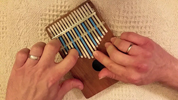 |
17-key Hugh Tracey "Treble" KALIMBA (a.k.a. "Thumb Piano," African Mbira)
This 17-key Hugh Tracey "Treble" Kalimba (a.k.a. "Thumb Piano," African Mbira, etc.) consists of a wooden board w/resonator and 17 staggered metal tines, tuned (from left to right): C6, A5, F#5, D5, B5, G4, E4, C4, B3, D4, F#4, A4, C5, E5, G5, B5, D6 . The lowest note is in the center, and the pitches raise, in alternation, from right to left (each side goes up in 3rds). There is one hole on the front (and two on the back), often used for vibrato effects. Instrument is held in the hands, its tines plucked with the thumbs, and used in a rhythmic, melodic, and/or textural fashion. Mine is supposed to be in G major, but by the time it'd found it's way to me, it'd "adjusted" to Ab. (It's not difficult to tune, I just left it "as is" for his video.) Ethnomusicologist High Tracey first discovered these instruments in South Africa, and began exporting them around the world in 1954. This is the first little tune I wrote on mine--enjoy!) |
|
BALINESE GAMELAN (Gendér): A 13-tone metallophone from Indonesia
A 13-tone metallophone, its keys strung together by cords on metal supports (sticking out of the underframe), hanging above tubular resonators. Mine is like two instruments in one--highest eight keys are Bb major pentatonic (w/Eb added in highest octave), the bottom five are Bb minor pentatonic. I'm only playing the highest eight notes in this video; the lower five are clanky, clunky, and undefined, but AWESOME for percussive purposes. Instruments similar to this have been used in film scores like the Japanese anime film Akira, as well as Alexandre Desplat's Girl With A Pearl Earring and The Golden Compass, among others. Authentic versions of this instrument do not conform to "Western" equal temperament. Best I can tell, mine was perhaps once similar to a "Gender barung slendro," loosely Bb-Db-Eb-F-Ab-Bb, in two octaves (Bbm/Dbmaj pentatonic). |
|
1940s Vintage TYPATUNE (musical typewriter)
A musical typewriter. Each key (32 keys total) sounds a piano-like note/chime. Invented by Bronx court stenographer Alexander Rose. Manufactured in Switzerland. GREAT for thriller/horror scores, due to its imperfect tuning and clunkiness. (Can you say "spooky themes based on character names?") |
|
CINEMATIC (horror/suspense/otherworldly) STEEL DRUMS
Somewhat "beat up" Steel Drums (early 2000s--from Myers USA oil drums, 0.8mm thickness), with the following INACCURATE tunings (as written on the drums):
Drum #1 (Lower register: G, A, B, C#, Eb, F, G, A, B; Higher register: C#, Eb, F, G, A, B)
Drum #2 (Lower register: F#, G#, Bb, C, D, E, F#, G#, Bb; Higher register: C, D, E, F#, G, Bb)
Note that each drum is 1/2 step off from the other. Again, NOT precise tuning. These are FANTASTIC for two-handed, rhythmic horror/suspense cues--especially when TWO people play these (using four hands, total), in similar rhythms. Impossible to reproduce with a sample library. These takes are 100% improvised, though based on a "target," of sorts. With effects added (these drums are dry in the vid), some pretty otherworldly atmospheres can be conjured :-) |
|
TRAPKAT Drum Controller (from Alternate Mode, Inc.)
A MIDI Drum Controller featuring 24 playing surfaces in a size/configuration rivaling an acoustic drum kit (10 large flat pads, 14 surrounding raised edge or "rim" pads). With its individual kick and hi-hat footpedal inputs, the TrapKAT offers a complete electronic percussion system in single, compact instrument. AWESOME as an "acoustic #drums" substitute (triggering samples only, so you can swap out drum sounds to find a perfect, customizable "acoustic" drumkit sound). In this video, I'm playing a collection of TAIKO drums, w/four sticks at once. |
|
WATERPHONE (a.k.a. "Ocean Harp"), bowed on a LAZY SUSAN
The classic "horror/mystery/suspense" percussion instrument, instantly recognizable for its ethereal/haunting sound, the result of (usually) bowing its bronze rods (of different lengths/diameters), which protrude from the rim of its stainless steel resonator bowl. Also has a cylindrical neck (to fill the device with water); moving the instrument side-to-side while bowing (or striking) its rods and/o bowl affects the water inside, producing the waterphone's signature "vibrant/ethereal" sound.In this vid, I'm bowing it on a LAZY SUSAN, lol. There is no water inside (and you're hearing it totally "dry," with no effects added). |
|
REMO THUNDER TUBE SPRING DRUM (horror/suspense/thriller drones)
A drum/tube with an oval head/skin and a long spring extending from its center. Makes a spectacular "thunder/drone" sound when shaken or struck. This is the original large-sized one, which is pretty rare (only 2 vids of it on the web). It has a bit of a "rattle" when loud, which I'm trying to fix, but make special note of how AWESOME this instrument's "quiet rumble" is (@0:26), when held super close to a stereo mic pair (you're hearing it totally "dry," with no effects added, in this vid). |
|
Mini ZENG HOU YI Bells (horror/suspense/thriller)
Tiny version of ancient (433 B.C., from the Tomb of Marquis Yi of Zeng) Chinese bells, hung on two wooden racks, played with brass tipped glockenspiel sticks (Balter Basics Series Birch BB12 Bell Mallets). |
https://www.youtube.com/watch?v=SUkaOGOwyhQ https://www.youtube.com/watch?v=SUkaOGOwyhQ
|
GRENDEL DRONE COMMANDER (rare pulse drone synthesizer)
IMHO, this is one of the coolest mono synths ever designed. In this video, you're hearing it totally "dry," with no effects (and, of course, in mono). Typically, I "jam out" on this thing for quite a while, recording literally everything. Then I edit out all but the coolest bits and (if it will be used as a foundation for a track) "beatmap" them in Logic, so they're to a grid, then add effects (at the very least, timed delays). But, as you'll hear, with the few clips I included, the unit by itself is great for "precursor to event" tension-building sounds. It's one of my favorite gear pieces--and perhaps that's surprising, since I'm mainly a guitar dork! This is one of about 750 that Eric Archer made (he has since created a modular version; check rarewaves.net). Indispensable for its beautiful, resonant sounds and very "playable" pulse drones. |
|
FOLKTEK IMPRESSIONIST DRUMSCAPE (rare monosynth groove box)
From Folktek's quadrum family, by Arius Blaze, and one of the most brutal & exotic groove boxes in all of history. (It can be heard droning in bits during Trent Reznor & Atticus Ross' GONE GIRL score.) Utilizes an analog circuit with a huge warm sound--occasionally loud and insane, and oftentimes very sweet tonally. Incorporates a wide range of textural soundscapes as well as straight analog drum synthesis. The synth is analog; the built in delay is digital. Five custom brass keys (playing 4 oscillators) and a powerful delay, all built into an antique wooden box. Only about 20 were ever made (and each is unique). Mine is the seventh one (Impressionist Drum Scape VII). |
|
SIDRASSI ORGAN (rare "touch" synthesizer)
This is one of my favorite "exotic" synths, and is quite rare. Of the few videos of it on the web, virtually all focus on its "noise-making" abilities. In this video, however, I attempt to showcase its unique MELODIC and RHYTHMIC capabilities (using its seven pressure-sensitive bars, tuning buttons, master pitch knob, master modulation/chaos knob, and 42 nodes). Enjoy! (It's totally "dry" in the video.) |
|
THINGAMAGOOP (V.2)
About the size of your average guitar pedal, Bleep Labs' Thingamagoop 2 generates digital or analog sounds from an analog VCO. It has an antenna—or LEDacle—sticking out the top, with a light at its end which, when pointed towards or away from the sensor, changes the frequency cutoff. Has switches and knobs to control the source and waveform, as well as an arcade style button on the side that cuts the audio in/out (making the device "somewhat" playable). But the beauty of this box is its sheer weirdness—white noise, odd frequencies, and sounds; one of the all time best noise machines. (Also has CV in/out to "communicate" with synths.) It's totally "dry," with no FX, in this video. |
|
SCIENCE FAIR ORGAN (Tandy Corp. / Radio Shack)
SCIENCE FAIR ORGAN: A build-it-yourself 2-Octave (monophonic) Electronic Organ, made in Japan for Science Fair/Tandy Corp. (Radio Shack). From the early 1970s. I got this for $14 off E-bay, the buyer stating it "probably didn't work." Luckily I found a photo of its correct wiring and got it up and running! It is MINT (though if I messed with the wiring more, it might sound "better"--but who wants that?). This is a short video of its raunchy, glitch-y, somewhat tweakable/tunable sound (totally dry, in mono, mic'ed to the left of its built-in speaker)! The coolest bit is at the end... |
|
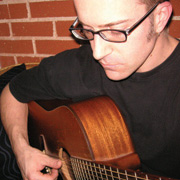 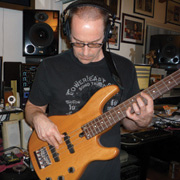 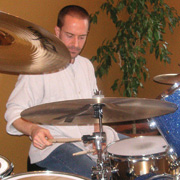 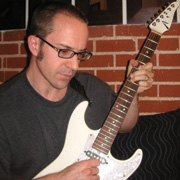   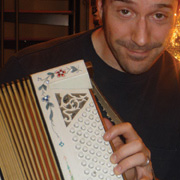              |





















